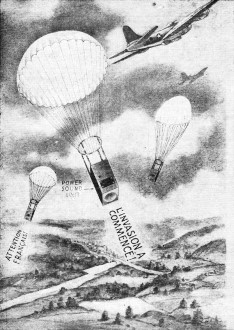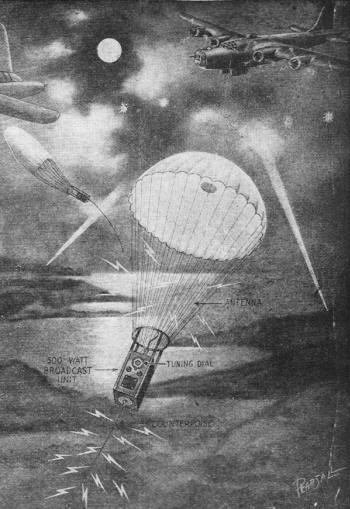Sky Radio Blankets the Enemy
|
|
Electronic counter-warfare (ECW) has been around nearly as long as electronic warfare (EW) itself. Controlling what a population hears on its radios is a fairly simple process since overwhelming a commercial broadcast station signal requires only a more powerful transmitter. It was commonplace during wartime for an invading force to set up high power stations in population centers to block signals meant to inform people of aggressor activity, or even to play music (a form of psychological warfare as well). Often, not only was the possession of a personal radio verboten, but even getting caught listening to one could spell real trouble. However, as with booze during Prohibition, the mere fact that something was outlawed did not prevent a large percentage of the population from owning and/or listening to broadcasts. This article by Hugo Gernsback proposes a method for informing a local area of an impending invasion force in order to forestall panic and irrational behavior - like rushing out into the open and becoming easy fodder for enemy fighters. It involves dropping by parachute many high power (500 watts or more), expendable transmitters with pre-recorded messages playing. The interesting aspect about his scheme is exploiting the short intended lifetime by pushing electronic components well beyond their intended parameters in order to save space, cost, and weight. His logic was that it wouldn't matter if an output stage vacuum tube designed for 10 watts and a 5 year lifespan was pushed to 100 watts and a 30 minute lifespan because the transmitters would never operate for more than 15 minutes or so - depending on the altitude at which they are deployed and the size of the parachute used. Sky Radio Blankets Enemy Communication is never more important than at the moment of invading occupied country. Instructions to the populace and directives to guerrillas or underground groups may be of great strategic importance at such moments. This article suggests an effective method for communicating with these friends and activating our potential allies. The present war has brought forth many new techniques in warfare and many other new and surprising ones will be originated before the war is brought to a successful conclusion. This war has also shown that during an invasion the population is easily panicked, and very frequently this hampers the invasion forces. During the invasion of France and the Low Countries, the demoralized population, as a rule, tried to get out in the open and started their trek away from the invasion forces. Much needless hardship, casualties and senseless killing of non-combatants was caused in this manner. In the United Nations' future invasions, in Europe and in Japan and elsewhere, it is often of great importance that the population should be informed when the invasion has been started and that the people be instructed what to do. At certain times military strategy requires that the population stay where it is; in other instances where a town is to be shelled it is necessary to inform the inhabitants to evacuate immediately, if large casualties are not to result. Naturally the enemy does not concern himself about such details, particularly where occupied country is concerned and the ruling military are not likely to give the occupied population much notice or comfort. For that reason the Allied Nations must do so themselves. Several means are open for them to do this. They can either use existing broadcast facilities and warn the population over their regular radio receivers, or otherwise shower the towns to be occupied with leaflets from the air. These two methods leave much to be desired. Frequently it is not possible to receive Allied broadcasts in occupied territory because the enemy may "jam" the usual broadcast wave lengths, making Allied transmissions almost impossible to be heard. If the Allies use short-wave frequencies, they know in advance that this will not be very effective because the population is under a death penalty if they use short-wave receivers, or listen to short-wave broadcasts. Leaflets are not very effective either because the people know that this is coupled with large hazards; the occupation authority is stern in this respect and will often execute those who pick up Allied leaflets and hand them around. A different method in spreading important information to the populace of occupied territories is shown on our front cover, as well as the accompanying illustrations on this page. The means concerns itself with launching over the occupied territory expendable radio means which can either be in the form of a floating broadcast station, or by direct sound method. Let us first consider the radio broadcast method. It has been suggested at times that a fairly strong broadcast station be set up in a bomber which can then broadcast to the population within a radius of from 50 to 100 miles. This method is not too good because an airplane during war conditions cannot circle too long over a city without being shot down. Furthermore, too many airplanes will be required to cover even a fair-sized territory.
The modus operandi is as follows: A large transport plane flying at night over a large city, for instance, will discharge a dozen or more of these 500-watt broadcast units. Before they leave the transport plane, the tuning dials are set and locked in such a manner that the broadcasting will be done on from three to six different wave lengths. These are the normal broadcast wave lengths on which the particular population usually tunes in on their regular broadcast frequencies, in order to listen in lawfully to the various radio broadcasts of their territory. By using a number of broadcast units, the entire city will be completely blanketed so that anyone who listens will, without any doubt, get the message that the Allies want the city to hear. The units are discharged from the transport at a height of about 25,000 feet. The parachutes will require anywhere from 18 minutes to 24 minutes to strike the ground, depending on the type of 'chute used, as well as weather conditions. This gives sufficient time for the broadcast, because the messages are usually short and no long-winded propaganda is necessary for an invasion. For instance, the message that the invasion has commenced, or that the population should either remain in the city (or evacuate), and other military information, is given in short crisp sentences. The message is recorded on either the new cellophane tape or a magnetic wire recorder is used. The message is repeated over and over until the broadcast unit finally hits the ground. The most important point to remember is that these units are powerful and of a strength of about 500 watts. This gives the same effect as if you had a 500-watt broadcast station right in your backyard! Therefore the recorded voice will come in on the average radio set like a thunderous voice of do doom, so loud that it will blanket any other radio program that might be on the air at the time. It will completely obliterate distant broadcast stations, and that is the only purpose of the scheme. In the end the effort will be worthwhile and the moderate cost of the few transmitters is cheap for the purpose which they achieve. More important, the Allies will not lose valuable lives because no one can get hurt, and it is doubtful even that the transport which discharges the broadcast units will be much molested at night and at a height of 25,000 feet. It may be asked: "How can you put a 500-watt broadcast unit into a weight of 200 pounds?" The answer is that it must be remembered that this is an expendable broadcast unit. Its total life is about 30 minutes. Consequently, everything in the set is designed for this purpose; everything that goes into it is naturally as light as it can be made. We have already valuable experience in this line with meteorological Radio-Sonde transmitters which weigh only a few pounds and are sent into the stratosphere. In our 500-watt broadcast unit, we overload all the tubes to three or four times their normal capacity. That means that we get an enormous gain in output. We can in this fashion increase the plate current in the output enormously simply because the unit has such a short life. We also get the maximum power out of the batteries which are to operate the unit. Amateurs many years ago learned that a remarkable increase in power and transmitting efficiency could be obtained by disregarding manufacturers' tube ratings. So-called 5-watt tubes were loaded to 50 watts. But the amateur never lived, who, to increase his transmitting efficiency, loaded his tubes and other equipment to a 20-minute life expectancy. Needless to say, fantastic increases of power may be expected from such loading, and this is the secret of our great power with equipment of such moderate size and weight. The illustrations show how the broadcast waves are radiated. Instead of using the ordinary 'chute guide lines, we substitute stranded wire. This gives us the antenna. For the counterpoise, we use a phosphor-bronze flexible wire, weighted at the end to steady it. The broadcast frequency will not "wander" too much with this arrangement and should therefore remain fairly fixed and steady. Within the broadcast unit, we have the record with the message, which weighs only a few pounds and is of not much consequence as far as weight is concerned. If we do not wish to use a radio broadcast unit for certain reasons, we have the alternative of using a Power Sound Unit, as is also illustrated. The working of this is parallel to the radio unit, except that the broadcasting is done by direct sound waves, just as any public address outfit would do. In this case, too, the power sound unit is also "loaded" to full capacity. In other words, it is forced far beyond its normal rating, because in this case also its total life is only less than half an hour. For that reason, the tubes and the output are forced to just below the burnout point. The power sound unit, as well as the 500-watt broadcast unit, both have timing mechanisms. Thus, in the case of the power sound unit, it does not commence the blasting of the message until it reaches a point about 3,000 or 4,000 feet up - then continues to repeat it in a stentorian voice so loud that people indoors can hear it clearly. As the unit descends further down, its voice becomes still stronger by the second until finally everyone in the neighborhood will have little trouble in hearing the intended message. I have dwelt in this article only on the more obvious features of the idea. There are a number of technical details in both methods that must be worked out, and experience will teach exactly how to obtain the maximum results from either outfit. It goes without saying that each of the two methods must use recordings in the language of the populace for whom the message is intended. For the French occupied territory, the language would be French; in China, it will be Chinese, etc. Yes, some of the units will be shot down if there are enemy fighter planes around. That is to be expected. During war one cannot expect to get 100% results from any means and that holds true for this scheme as well. It should, however, prove a valuable adjunct for our forces.
Posted January 4, 2021 |
|


